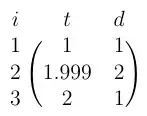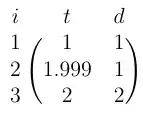I'm looking to calculate the exponential moving average & exponential moving variance of a continuous series of request/responses, using each response's duration and the interval (time delta) since the previous response.
Since the only pieces of information we have are response duration & timestamp, but we want concurrency, we can use $concurrency = rate \cdot duration$. And we can derive instantaneous $rate$ as $rate = 1 / \Delta t$.
For EWMA & EWMV, we'll use irregular weighted versions of EWMA 1 2 and EWMV 1 2. Weighting based on $\Delta t$ should smooth out the extreme values produced by $rate = 1/\Delta t$.
Putting it all together we have:
$r_i = 1 / (t_i - t_{i-1})$
$x_i = r_i \cdot d_i$
$\alpha_i = 1 - e^{-(t_i - t_{i-1})/\tau}$
$\mu_i = \mu_{i-1} + \alpha_i(x_i - \mu_{i-1})$
$\sigma_i = (1 - \alpha) (\sigma_{i-1} + \alpha (x_i - \mu_{i-1})^2)$
Where
- $t_i$ is the timestamp of the response
- $d_i$ is the request/response duration
- $r_i$ is the instantaneous rate
- $x_i$ is the instantaneous concurrency of the response
- $\tau$ is the time constant or window size
- $\mu_i$ is the EWMA of the concurrency
- $\sigma_i$ is the EWMV of the concurrency
Lets look at some examples where we know approximately what the results should be.
To start, lets assume we've started with an extremely steady concurrency, with average 2, and 0 variance. Let $\tau = 2$, $t_0 = 0$, $\mu_0 = 2$, and $\sigma_0 = 0$.
We then receive the following samples:
So we had 2 requests at $t=1$ and $t=2$ with $duration=1$, and another request slightly before the end at $t=1.999$ with $duration=2$. So effectively for the entire time period between $t=0$ and $t=2$ the concurrency was $\approx2$.
However when we run the calculations we come up with:
$\mu_4 = 2.367523$
$\sigma_4 = 1995.998844$
We should have expected $\mu_4 \approx 2$ and $\sigma_4 \approx 0$
Lets look at another example. Since the last 2 samples ($i=2$ & $i=3$) were nearly simultaneous, we should be able to flip them around without changing the result much.
This results in:
$\mu_4 = 2.261011$
$\sigma_4 = 498.048046$
Again, both values are higher than they should be, $\sigma$ is radically different, and even $\mu$ has a greater difference than there should be.
Where I believe this is breaking down is in the calculation of $x_i$. While $r_i$ is the instantaneous rate, $d_i$ is not an instant.
When $\Delta t$ is very small, $r_i$, and $x_i$ become very large. Now $\alpha_i$ is playing a part in scaling this back down since it's based off $\Delta t$, but obviously not enough.
So my question is: What is the proper way to accomplish this?
I would guess that when calculating rate, the duration needs to be scaled down with some exponential relation to $\tau$ and $\Delta t$, but not sure what that should be. I also don't want to rely on having to smooth it out too much or that kinda defeats the point of calculating the variance. I realize none of this is going to be exact, just need to be able to figure out what reasonable bounds for real concurrency should be.

